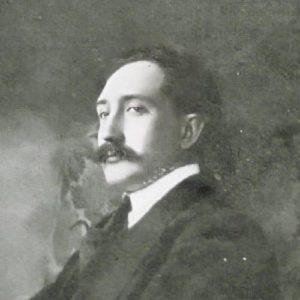Gabriel Grovlez

Gabriel Grovlez (1879-1944) was born in Lille, Northern France, in 1879 and died in war-torn Paris in 1944. From among his teachers, who include Gédalge and Lavignac, Fauré must surely rank as his strongest influence, and this is readily heard in his small but significant oeuvre of solo piano pieces as well as his music for stage and chamber ensembles. Interestingly, most of the piano music was published over a period of around a dozen years (1907-1919), and in the lull between these works and his Impressions (two pieces) of 1934, Grovlez was compositionally preoccupied with songs and chamber pieces, many of which languish patiently on the shelf awaiting a wholehearted appraisal. There is, as well as his notable penchant for elegance and poetical lyricism, a considerable wit to enjoy, too (take Les Ânes – The Donkeys – from L’Almanach, for example), and indeed the fact that Grovlez’s middle years were spent fulfilling the duties of assistant conductor and choir leader of the Opéra-Comique seems especially revealing of the man’s musical personality and capacity for successfully intertwining serious and less serious genres.
Grovlez was quite a cosmopolitan character; besides making a notable mark in his native country (he was, latterly, a professor of chamber music at the Paris Conservatoire), he travelled to the United States and Africa, as well as across Europe. Although we tend to remember Grovlez today for his influence primarily as a composer in the mould of Fauré or Debussy, bringing a quirky quality to some of his writing more than occasionally reminiscent of Poulenc, it was as a conductor that Grovlez initially made an impact. Moreover, we should not overlook the fact that he gave the inaugural performances of some highly treasured works by the likes of Ravel (Ma Mère l’Oye) and Fauré (Dolly Suite), a piano duet which has earned an especially important place in the hearts of countless amateur pianists, young and old. Nor should we neglect his sizeable impact in resurrecting music by, for example, Monteverdi, Rameau, Gluck and Lully. His charming, delightfully compact and eclectic resourcefulness also became channelled into stage works such as operas and ballets, as well as symphonic poems, vocal and choral pieces, memorable for their warmth of personality and, at times, startlingly farsighted stylistic direction.
To counter those who feel that Grovlez was, not unlike Erik Satie, disinclined to write music of complexity in favour of irony and understatement, pianists might wish to get their hands on a copy of Grovlez’s Deux études de difficulté transcendante (1919), which contrasts superbly with his first published work for the instrument in 1907: Au jardin de l’enfance (In the Garden of Childhood). There remains a risk that composers such as Grovlez become recognised only in light of their various stylistic borrowings, in this case placing him somewhat in the shadow of Debussy and Fauré, rather than as a musician of the highest ranking in his own right, and I believe that by bringing works such as the marvellous L’Almanach aux images to a wider audience by means of sensitive arrangements can only help matters. Doubtless, now that Grovlez’s music has emerged from copyright, we can expect to see a growing number of such enterprises.
Grovlez L’Almanach aux images arr. Tanner (Flute & Piano)– – – – –
Grovlez: Sérénade arr. Tanner for Flute and Piano– – – – –